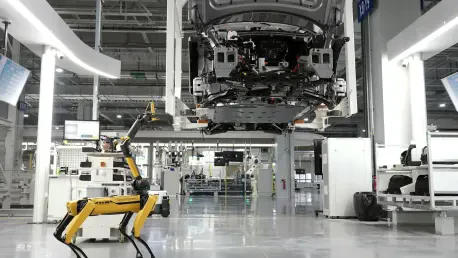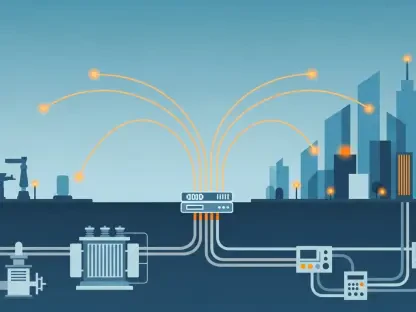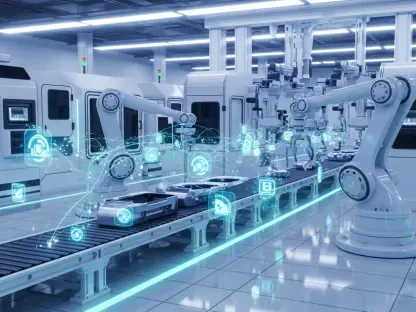The manufacturing landscape is undergoing a profound transformation, driven by the rapid adoption of artificial intelligence (AI), which is set to redefine how industries operate in the coming years. A recently published report forecasts that the AI in manufacturing market will experience an extraordinary compound annual growth rate (CAGR) of 35.3%, expanding from USD 34.18 billion in 2025 to a staggering USD 155.04 billion by 2030. This remarkable growth trajectory highlights the pivotal role AI is playing in modernizing production processes across sectors like automotive, electronics, aerospace, and consumer goods. Technologies such as machine learning, natural language processing, and computer vision are not just tools but game-changers, enabling smarter decision-making, reducing operational costs, and enhancing overall efficiency. The concept of the “smart factory” is no longer a distant vision but a tangible reality, as manufacturers increasingly rely on data-driven systems to stay competitive in a fast-evolving global market. This surge in AI adoption signals a shift toward intelligent automation, where real-time insights and predictive capabilities are becoming integral to factory floors worldwide.
Revolutionizing Production with Smart Factories
The integration of AI with the industrial Internet of Things (IIoT) and cloud-based analytics is fundamentally changing the way manufacturing plants function, ushering in an era of smart factories. These advanced environments leverage interconnected devices and systems to collect and analyze data in real time, enabling instant decision-making that optimizes production workflows. Unlike traditional setups where delays and inefficiencies often plagued operations, smart factories can detect issues as they arise, minimizing disruptions and slashing costs. This transformation allows manufacturers to monitor equipment performance, track supply chains, and adjust processes dynamically, all while maintaining a high level of precision. The result is a significant boost in productivity, as downtime is reduced and resources are allocated more effectively. Industries ranging from heavy machinery to consumer electronics are adopting these technologies to stay ahead, recognizing that the ability to adapt quickly to market demands is now a critical factor for success in a competitive landscape.
Beyond the immediate benefits of efficiency, smart factories are also paving the way for long-term sustainability in manufacturing. AI-driven systems optimize energy consumption by identifying wasteful practices and suggesting alternatives, aligning with global goals for reducing environmental impact. Additionally, the seamless connectivity of these factories fosters collaboration across departments and even between different plants worldwide, creating a cohesive network of operations. This interconnectedness not only improves transparency but also enhances the ability to respond to unexpected challenges, such as supply chain interruptions or sudden shifts in consumer demand. As more manufacturers invest in these intelligent ecosystems, the traditional boundaries of production are being redefined, setting a new benchmark for what modern manufacturing can achieve with the power of AI at its core.
Leading Applications Transforming the Industry
Predictive maintenance has emerged as a standout application of AI in manufacturing, commanding the largest market share in 2024 and expected to maintain its dominance through 2030. By harnessing data from sensors embedded in machinery, AI algorithms can predict equipment failures before they occur, allowing for timely interventions that prevent costly downtime. This is particularly vital in high-stakes industries like automotive and energy, where even a brief halt in production can result in significant financial losses. Unlike traditional maintenance approaches that react to problems after they arise, predictive maintenance offers a proactive solution, optimizing schedules and reducing unnecessary repairs. The financial benefits are clear, with improved uptime and extended asset life delivering a strong return on investment, making this application a top priority for manufacturers aiming to transition to data-centric operations.
Another critical area where AI is making waves is in quality control, ensuring that products meet stringent standards without the inefficiencies of manual inspections. Advanced algorithms, often paired with computer vision, can detect defects or anomalies in real time during production, flagging issues that might otherwise go unnoticed until later stages. This capability not only saves time but also reduces waste by catching problems early, preventing defective goods from reaching the market. For industries like electronics, where precision is paramount, such technology is invaluable in maintaining brand reputation and customer trust. As AI continues to evolve, its applications in quality assurance are expected to become even more sophisticated, further enhancing the ability of manufacturers to deliver flawless products consistently.
Core Technologies Fueling the AI Boom
Machine learning stands at the forefront of AI technologies in manufacturing, recognized as the dominant force in 2024 due to its unparalleled ability to process vast amounts of data and uncover actionable insights. By analyzing information from sensors, production lines, and enterprise systems, these algorithms identify patterns that humans might overlook, enabling precise demand forecasting, anomaly detection, and process optimization. This adaptability makes machine learning ideal for the dynamic, often unpredictable nature of manufacturing environments, particularly in sectors like automotive and electronics. Its integration with IIoT platforms and cloud computing further amplifies its impact, allowing for real-time updates and scalability across operations. As a foundational technology, machine learning is not just supporting current needs but also laying the groundwork for more advanced AI implementations in the future.
Looking ahead, emerging technologies such as generative AI, digital twins, and autonomous robotics are set to push the boundaries of what’s possible in manufacturing innovation. Generative AI holds the potential to revolutionize product design by creating multiple prototypes rapidly based on specified parameters, significantly shortening development cycles. Digital twins, virtual replicas of physical systems, enable manufacturers to simulate and test processes in a risk-free environment, identifying inefficiencies before they impact real-world operations. Meanwhile, autonomous robotics enhance factory floor efficiency by taking on repetitive or hazardous tasks, freeing human workers to focus on more strategic roles. Together, these cutting-edge tools promise to create a manufacturing landscape that is not only more efficient but also more creative and responsive to evolving market needs.
Regional Dynamics and Industry Leaders
Europe is positioned as a significant growth hub for AI in manufacturing, driven by a robust commitment to industrial modernization and supportive government policies promoting digital transformation. Investments in research and development, coupled with a highly skilled workforce, have created an environment ripe for AI adoption across the region’s advanced industrial base. European manufacturers are leveraging AI for real-time production monitoring, autonomous decision-making, and energy optimization, all while adhering to strict sustainability and regulatory standards. This focus on balancing innovation with environmental responsibility sets the region apart, making it a key contributor to the global market. As Europe continues to prioritize smart factory initiatives, its influence on shaping industry trends and standards is expected to grow, reinforcing its role as a leader in this technological shift.
On the competitive front, major corporations such as Siemens, NVIDIA, IBM, and Microsoft are spearheading the AI revolution in manufacturing with innovative solutions that address complex challenges. These industry giants offer a range of tools, from predictive maintenance software to digital twin technologies, designed to enhance scalability and impact. Their efforts are often bolstered by strategic partnerships that bring AI solutions to real-world applications, transforming operational hurdles into opportunities for growth. For instance, collaborations between tech providers and manufacturers have led to breakthroughs in equipment monitoring and process automation, demonstrating the tangible benefits of AI deployment. The competitive landscape remains dynamic, with these leaders continuously pushing the envelope to deliver cutting-edge advancements that redefine manufacturing capabilities on a global scale.
Navigating Opportunities and Obstacles
The future of AI in manufacturing is brimming with potential, particularly in areas like remote plant management and smart customization. Remote management systems powered by AI enable oversight of global operations from a centralized location, reducing the need for on-site presence while maintaining control over production quality and efficiency. This capability is especially valuable for multinational companies managing multiple facilities across different time zones. Additionally, AI facilitates a shift from mass production to personalized manufacturing, allowing companies to tailor products to specific customer preferences without sacrificing speed or cost-effectiveness. Such advancements highlight how AI can balance scalability with individualization, offering manufacturers a competitive edge in meeting diverse market demands while streamlining operations.
However, the path to widespread AI adoption is not without challenges that must be addressed to unlock its full potential. Many manufacturers face significant hurdles with legacy infrastructure, where outdated systems struggle to integrate with modern AI tools due to poor data quality or incomplete datasets. The complexity of deploying AI across an entire enterprise also presents logistical and financial barriers, requiring substantial investment and organizational restructuring. Furthermore, maintaining the accuracy of AI outputs in the face of fluctuating production conditions remains a persistent issue, as dynamic environments can disrupt predictive models. Overcoming these obstacles will require a concerted effort to modernize systems, invest in training, and develop flexible AI solutions that can adapt to the unique needs of each manufacturing setting.
Reflecting on a Transformative Journey
Looking back, the journey of AI in manufacturing revealed a landscape that was ripe for disruption, with early adopters demonstrating the power of predictive maintenance and machine learning to enhance efficiency. The projected growth from USD 34.18 billion in 2025 to USD 155.04 billion by 2030, at a CAGR of 35.3%, underscored the momentum that had been building as industries embraced data-driven strategies. Europe’s rise as a key player, alongside innovations from leading companies, painted a picture of an industry that had begun to redefine itself through intelligent automation. Challenges like data integrity and deployment complexities were acknowledged as significant hurdles that tested the resilience of manufacturers during this period of rapid change.
Moving forward, the focus should shift to actionable strategies that build on past progress, such as fostering collaborations between technology providers and manufacturers to address integration challenges. Investing in workforce training to bridge the gap between human expertise and machine intelligence will be crucial, ensuring that employees are equipped to leverage AI tools effectively. Additionally, prioritizing scalable solutions that can adapt to varying production environments will help mitigate the risks associated with dynamic conditions. As the industry continues to evolve, embracing these steps will ensure that the transformative potential of AI is fully realized, driving manufacturing into a future of unparalleled innovation and efficiency.









